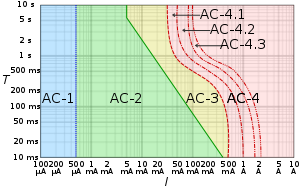Suicide/Electrocution

Electrocution is a colloquial term for a death provoked by external electrical currents. It describes a fatal electric shock. To understand the underlying mechanisms of an Electrocution one should know the basics of electricity and conductance.
The effects of electrical current on the human depend on its magnitude, and in the case of alternating current (AC) on its frequency. A current's magnitude depends on electric potential difference of the two electric poles (power source voltage and Ground) and the electric resistance between the poles. The frequency of an alternating current is determined by the source's frequency (60 Hz or 50 Hz for utility grids or 25 Hz or 16 Hz for some European Railway grids).
Electric shocks as causes of death
[edit | edit source]Most injuries or deaths caused by electric shock are involuntary inflicted, e.g. domestic or work related accidents with AC utilities. Work related accidents make up the majority of deaths. 4 in 5 deaths were work related. Voltages and frequencies can vary, if industrial or commercial electric infrastructure comes into play. The readily available domestic electric infrastructure responsible for 1 in 5 deaths usually only exposes 110 V or 220 V at 50 Hz or 60 Hz.
Differentiating between electricity related accidents and Suicides may often be impossible. Due to the low number of electrocutions (2 per million) compared to confirmed Suicides (100 per million), one can safely assume, that only a marginal amount of Suicides are conducted using electric shocks.
Low Voltages
[edit | edit source]Alternating Mains voltages allows low AC currents around 1 Ampere. These currents induce involuntary muscle spasms. The spasms can occur on muscles in the electricities path. If the heart is affected, the shock may induce cardiac fibrillation. Additionally spasms of the limbs can suppress the human bodies reflex to disengange from the positive pole. The latter effect is reinforced by the frequency of the current, which is a magnitude faster than reflex times.

AC-4.3: most right red line: over 50% probability of fibrillation
from: Factors in lethality of electric shock
Higher currents induced by higher voltages or long exposure times result in electrical burns.
A major limiting factor for lethal currents is time. Accidential exposure to household currents is often limited by the used fuses and circuit breakers, which automatically break the electrical circuit when high amounts of currents flow.
These factors do allow Electrocution using a household small appliances utility grid, but do not favor lethal currents and limit Suicide options using readily available electricity, due to the needed knowledge of the inherent limitations.
High Voltages
[edit | edit source]High Voltage electricity sources (1kV and up) are generally well secured and not readily available. Nevertheless they are in principle more dangerous. Higher Voltages induce higher currents in resistors. These higher currents and higher voltages allow more electric power to flow through the resistor. The electric power depends quadratically on the applied Voltage, therefore doubling the Voltage quaddrouples the power, tenfold the electric Voltage induces a hundred times the power. This power will get transformed to heat by the resistor. In case of an accident or Suicide the human body would be said electrical resistor.
Additionally High Voltage circuits break at much higher currents and the human body show a lower resistance to higher voltages, allowing higher currents. Thus a fatal event with High Voltage electricity becomes a death, which is not induced by bioelectrical and neurological issues, but by heat. The current searches the fastest path through the inhomogenous resistor (e.g. a human body) and burns everything in this path in seconds.
- High Voltage Lines
-
Overhead power line
-
Bottom-contact (third rail) Amsterdam
-
Tram overhead electricity source
-
Railway electrification
Available High Voltage lines like High Voltage Overhead power line employ 50 kV and up. The lines are connected to their supporting pylons or steel towers with resistors long enough to remove climbers out of the cables reach, therefore disallowing contact to the electrical ground pole. However as carbon fiber fishing rods are conductive, using one long enough to reach High Voltage lines, self-electrocution can easily be achieved.
Railway lines only employ around 1 kV to 15 kV, but are reachable as a a "third rail" (1kV), through the roof of a tram or through comparably small steel constructs (around 15 kV). These "median" Voltages produce arcs, which may inflict fourth degree burns. Therefore access to such High Voltage lines is restricted by OHS measures.
References
[edit | edit source]- ↑ Weineng Wang, Zhiqiang Wang, Xiao Peng, Effects of the Earth Current Frequency and Distortion on Residual Current Devices, Scientific Journal of Control Engineering, Dec 2013, Vol 3 Issue 6 pp 417-422




